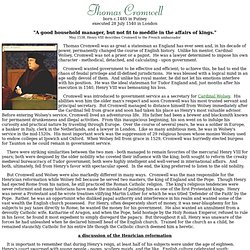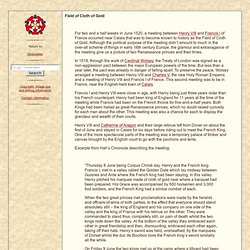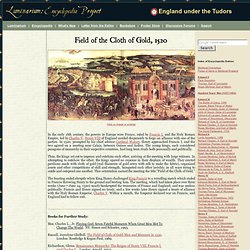

Www.jrwschool.com/Henry VIII Revision Guide.pdf. Cardinal Wolsey. Cardinal Thomas Wolsey was born in c1473 and died in November 1530.

Wolsey was Henry VIII's most important government minister who acquired much power which ended only after he failed to secure for Henry a divorce from Catherine of Aragon. Wolsey was the son of a butcher and cattle dealer. He had a relatively comfortable upbringing and was educated at Magdalen College, Oxford University. Wolsey decided on a life devoted to God and he joined the church. He held a number of private chaplainries but he soon came to the attention of HenryVII as Wolsey was quickly identified as a man who had excellent managerial skills with a very good grasp of detail. Wolsey continued to serve at court when Henry VIII succeeded his father in 1509. However, Wolsey quickly outgrew this support and he became the unofficial royal secretary. When in London, Wolsey lived in York Place (now gone but where Whitehall now stands) and he also owned Hampton Court as a country residence. Thomas Cromwell. Born c.1485 in Putney executed 28 July 1540 in London "A good household manager, but not fit to meddle in the affairs of kings.

" May 1538, Henry VIII describes Cromwell to the French ambassador Thomas Cromwell was as great a statesman as England has ever seen and, in his decade of power, permanently changed the course of English history. Unlike his mentor, Cardinal Wolsey, Cromwell was not a priest or a papist. He was a lawyer determined to impose his own character - methodical, detached, and calculating - upon government. Field of Cloth of Gold. For two and a half weeks in June 1520, a meeting between Henry VIII and Francis I of France occurred near Calais that was to become known to history as the Field of Cloth of Gold.

Although the political purpose of the meeting didn’t amount to much in the over-all scheme of things in early 16th century Europe, the glamour and extravagance of the meeting give us a picture of two Renaissance princes and their times. In 1518, through the work of Cardinal Wolsey, the Treaty of London was signed as a non-aggression pact between the major European powers of the time. But less than a year later, the pact was already in danger of falling apart. To preserve the peace, Wolsey arranged a meeting between Henry VIII and Charles V, the new Holy Roman Emperor, and a meeting of Henry VIII and Francis I of France. This second meeting was to be in France, near the English-held town of Calais. Francis I and Henry VIII were close in age, with Henry being just three years older than his French counterpart. Field of Cloth of Gold. In the early 16th century, the powers in Europe were France, ruled by Francis I, and the Holy Roman Empire, led by Charles V.

Henry VIII of England needed desperately to forge an alliance with one of the parties. In 1520, prompted by his chief advisor Cardinal Wolsey, Henry approached Francis I, and the two agreed on a meeting near Calais, between Guines and Ardres. The young kings, each considered paragons of monarchy in their respective countries, had long been rivals both personally and politically. Thus, the kings set out to impress and outshine each other, arriving at the meeting with large retinues. In attempting to outshow the other, the kings spared no expense in their displays of wealth. The feasting ended abruptly when King Henry challenged King Francis to a wrestling match which ended in Francis throwing Henry to the ground and besting him. Books for Further Study: Mee, Charles L., Jr. The Reformation. King Henry VIII - A Summary.